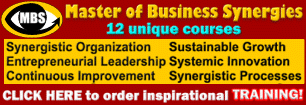|
Winning & Retaining Customers |
by Vadim Kotelnikov, Founder, The first-ever BUSINESS e-COACH for Innovative Leaders, 1000ventures.com
"Any fool can paint a picture but it takes a wise man to be able to sell it" - Samuel Butler
|
|
Your Business is Ruled by the Marketplace "You don't decide what business you are in; the marketplace decides that for you... People will only buy what they want to buy, or are afraid not to buy, at a given moment in time"1. Tailoring your business plan to what the market will buy is always a better, more successful strategy than developing a new product or service without knowing precisely the customers for it and hoping that people would buy it because it's good. Many things are good, and people need many things. But the "need" is not enough. "Nobody buys what they need. Before people will buy something they "need", two things have to happen:
Before people know they need something, you often have to spend lots of money educating them about why they need it."1 While preparing your business and marketing plan, anticipate also the curveballs that the marketplace will throw at you and may cause you to change direction. Marketing is positioning. You need to learn to position your product or service in the mind of the prospect. Remember also that test marketing of your product or service is a very important component of your entrepreneurial success. Your company should deliver a particular customer value proposition to a definable market in order to exist. The delivery of the customer value proposition relies on a business design, which uses key business processes to harness the distinctive capabilities, competences and resources of your firm to deliver superior value to relevant markets. Customer value propositions and business designs compete and collaborate for customers, resources, infrastructures and skills on strategic landscapes.4...More Three Stages of the Marketing Process Marketing is essentially a 3-stage process:
Marketing & Selling Strategy at Different Company Growth Stages "Successful businesspeople are, first and foremost, salespeople. If you cannot sell, do not, we repeat, do not start your own company."1 The analysis of market potential separates the inventors from entrepreneurs. Many good products are never successfully commercialized because their inventors don't stop to understand the market or assemble the management team necessary to capitalize on the opportunity. The first thing to do is to research all competitors for the product or service and ask the right questions:
A venture's first strategic marketing focus should not be end-user customers or, in fact, the commercial marketplace at all. Especially for launch-stage companies, the first critical marketing issue is not cozying up to end-user customers. The first critical issue is being able to market the venture opportunity to appropriate sources of funding for the company itself. The most appropriate initial funding source may be employees, family and friends, third-party angel investors, a venture capital fund, a corporate partner, a licensee, or some combination of these. CollisonÆs Axiom of Selling: "æSellingÆ isnÆt happening when your company is talking; æsellingÆ happens when your targeted prospect is talking." Marketing isn't advertising. Selling isn't the same as marketing. And advertising isn't selling. But no matter what your company does, it needs them all ¢ at least in one form or another. "Comfort, complacency and confidence - the "Cs" - spell disaster for an entrepreneurial company1". You should always be insecure about your markets, your products & markets, your competition, your legal environment and yourself. There are no final answers to these questions. You should ask them every day. Develop market intelligence and get prepared to adapt quickly to market changes. Build rapport with your customers - if customers are served by someone they feel instinctively comfortable with, then they will choose to come back. Emotional Marketing Marketing strategies without emotion will not work. Emotional marketing is better in many instances than rational marketing that focuses on product attributes. Capturing minds is one thing; capturing hearts is quite another. Build emotions in your marketing strategies; don't always chase "share of wallet - chase "share of heart". Employ strategies that would make decisions very emotionally driven and remove the rational questions that might drive the prospect elsewhere...More Experiential Marketing Experiential marketing goes well beyond simply delivering consumption experiences to consumers as a way to give them the information they need to make a purchase decision. Experiential marketing can also be applied creatively to deliver greater impact while reducing costs and to weave in market research or customer insights research in ways that could not be done before. Experiential marketing is the difference between telling people about features or benefits within the confines of the thirty-second TV spot and letting them experience it and get their own "a-ha!" event5...More Get the Most Out Of Available Information Technology Tools By using e-business solutions, successful companies are learning to get the most out of available IT tools. Employ information technology for understanding industry trends and customers' needs, for gathering and interpreting data about your ultimate customers, including demographics, trends, and buying behavior, and for expanding or solidifying relationships with your customers through the Web. Leveraging Your Service-Profit Chain The service-profit chain is a powerful phenomenon that stresses the importance of people - both employees and customers - and how linking them can leverage corporate performance. The service-profit chain is an equation that establishes the relationship between corporate policies, employee satisfaction, value creation, customer loyalty, and profitability...More |
||||||||||||||||||||||||||||||||||||||
Bibliography:
-
"MoneyHunt", Miles Spencer and Cliff Ennico, 1999
-
"Growing Your Business", PricewaterhouseCoopers, 2001
-
"Extreme Management", Mark Stevens, 2001
-
"Managing Complexity", Robin Wood, 2001
-
"Experiential Marketing", Dr. Augustine Fou, 2003
-
"The 22 Immutable Laws of Marketing in Asia", Al Ries, Jack Trout and Paul Temporal, 2003.
-
"The Seven Deadly Skills of Competing", James Essinger & Helen Wylie, 1999






